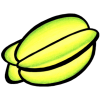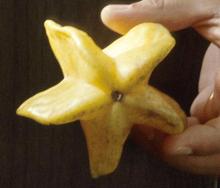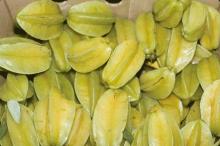Maturity and Quality
Fruit color changes from green to yellow which is accompanied by an increase in soluble solids including sugars (sweetness). Carambolas should be picked when fully yellow to assure good eating quality. However, color break (1/2 to 3/4 of fruit is yellow) is used as the commercial maturity index because these fruits are firmer and easier to handle.
- Yellow and firm fruits with no brown discoloration on the skin and the five ribs
- Crisp and juicy flesh
- Cultivars vary in their sweetness (glucose, fructose and sucrose) and acidity (oxalic and malic acids); sweet (pH = 3.8-4.1) cultivars include ‘Arkin’ and tart (pH = 2.2-2.6) cultivars include ‘Golden Star’
- Freedom from bruises, insect damage, bird damage, windscar, and decay
- Carambola fruits are good sources of vitamins A and C
Postharvest Handling and Storage
5-10°C (41-50°F), depending on cultivar and production area.
Lower temperature may induce chilling injury depending on cultivar, ripeness stage, and temperature and duration of storage.
| Temperature | 5°C (41°F) | 10°C (50°F) | 15°C (59°F) | 20°C (68°F) |
| ml CO2/kg·hr | 5-10 | 8-15 | 12-18 | 20-40 |
To calculate heat production multiply ml CO2/kg·hr by 440 to get Btu/ton/day or by 122 to get kcal/metric ton/day.
Green color of carambolas continues to disappear during storage at 15°C (59°F) or 20°C (68°F) and some improvement in flavor due to loss of acidity may be noted. These changes can be slightly accelerated with exposure to ethylene (100 ppm for 24 hours), but such treatment may increase decay incidence and severity.
90-95%
Lower humidity results in more severe symptoms of rib browning.
Less than 1.0 µl/kg·hr at 20°C (68°F)
Carambola is a nonclimacteric fruit.
Florida carambolas can be kept in air at 5°C (41°F) for 4 to 6 weeks provided that water loss is minimized (by high relative humidity and/or packaging film barriers).There are no published data on their response to atmospheric modification.
Disorders
Chilling injury. Symptoms include surface pitting [pits are either small
Physical Injury. Rib-edge browning and stem-end browning can result from surface abrasions and other types of bruising. The browning intensity increases with water loss from the fruits. Handling carambolas with care to minimize bruising is essential to reducing postharvest losses.
Shriveling. Symptoms become visible when the carambolas lose about 5% or greater of their weight due to water stress.
Heat damage. Skin browning and flesh softening may occur when carambolas are exposed to heat treatments [such as 46°C (115°F) for 35 to 55 minutes] for insect control to satisfy quarantine requirements. Better alternatives may be cold treatment and/or irradiation.
Postharvest diseases of carambolas may be caused by Altenraria alternata (especially on chilled fruits), Cladosporium cladosporioides, or Botryodiplodia theobromae. These usually occur at physically-damaged sites on the fruits during prolonged storage. Minimizing physical damage throughout the harvesting and postharvest handling operations and prompt cooling to 5°C (41°F) can greatly reduce incidence and severity of postharvest diseases on carambolas.





